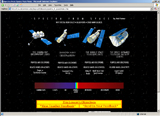Spectra From Space
Why go to the expense of launching satellites to gather spectral data in space? The earth's atmosphere does not allow light of all wavelengths to pass through it. In order to see gamma, X ray, ultraviolet (UV), infrared, and microwave radiation, we must place telescopes and other light-gathering instruments above the atmosphere. Students investigate satellite missions operating in four electromagnetic bands using the Internet and hands-on activities.
Key Questions
1. What are the four major regions of the electromagnetic spectrum?
2. What four satellites are used to study these regions of the electromagnetic spectrum?
3. Why do you need technology to study these regions of the electromagnetic spectrum?
Learning Objectives
1. Students will be able to identify four different regions of the electromagnetic spectrum and order them by wavelength.
2. Students will be able to describe one or more of the four satellite missions featured in the site, its capabilities, and the objects it observes.
3. Students will conduct and draw appropriate conclusions from some or all four of the hands-on activities.
Detailed Learning Objectives
General Subject Areas
Astonomy, Space Science, Physics
|
 Author: Neil Fetter
Author: Neil Fetter
VIEW THE LESSON
Student Activities
Each Section focuses on a satellite in a different wavelength region of the electromagnetic spectrum. In each area there is a page of general background information on the mission, a hands-on activity with real or simulated light (simulated for x-ray), and links to the NASA sites on the spacecraft and science of the mission.
Student Prerequisites
Students WILL need assistance from instructor with hands-on activities.
Assessment
Successful completion of student hands-on experiences.
Student questionnaire
Answer key
Extended Learning
N/A
|
View Teacher Feedback
Send Us Your Feedback
Time Requirements
Approximately 1-2 hours preparation. Students can spend 1-4 class periods learning about the four satellites featured. Each of the four hands-on activities can be done in a single class period.
Materials Required
-Internet connected computer with WWW browser program
-Geiger counter
-Window screen
-Shoe box top
-Sand
-UV beads
-Diffraction grating (sources suggested)
-Utility knife or scissors
-Pen or pencil
-Shoe box
-Tape
-Index cards
-Rubber bands.
-Liquid crystal sheet (available at museum, nature stores, and science supply catalogs)
Required Plugins
N/A
Additional Resources
N/A
Best For Grades
middle school
National Science Education Standards (NSES)
grades 5-8
grades 9-12
State Science Standards
Grade 7 Life Science
Grade 8 Physical Science
Grades 9-12 Earth Sciences
Have a science question? Visit our Ask an Expert page. Email questions or comments about SEGway resources to: outreach@ssl.berkeley.edu
|












